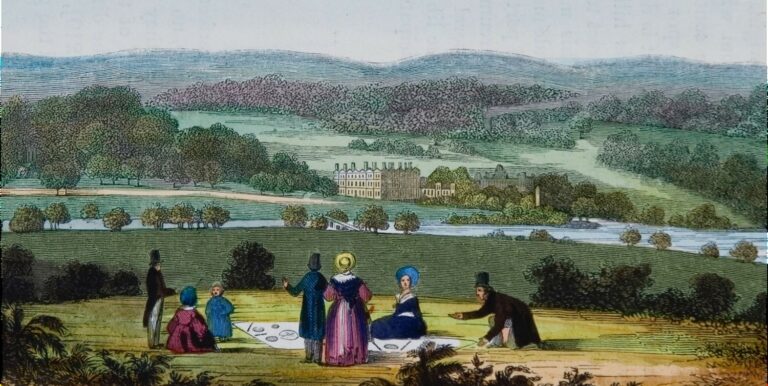Gloucestershire landowner Benjamin Hyett (1708–1762) began developing the garden in 1738, using the natural slope of the combe behind Painswick House to create a landscape of leisure and spectacle.
The garden was designed as a playful space for entertaining. A central path led visitors through shifting scenes and architectural features, with paths laid along the valley sides to form a circuit walk. Natural springs were channelled to feed a pool and pond, creating reflections that enhanced the sense of drama and movement.
Near the entrance stood a Gothic summerhouse known as the Eagle House, which offered views across the valley to the Doric Seat. Within the woodland, the striking Red House pavilion stood at the heart of the circuit path, which curved westward towards the Exedra, a white-painted wooden screen with Gothic arches, battlements, and pinnacles that framed picturesque views of the surrounding landscape.
Few contemporary sources about the garden survive. By 1748, the garden was established enough for local artist Thomas Robins (1716–1770) to be commissioned to record it in a detailed painting. Centuries later, this work became the key reference for its restoration. One rare contemporary description, from 1757, comes from Bishop Pococke (1704–1765), who praised its woodland walks, use of water, architectural features, and kitchen garden. At its Rococo peak, the garden was a place of fashionable display where society guests strolled through elaborate scenes, attended elegant garden parties, and paused to socialise in architectural stops along the way while enjoying views of the surrounding countryside.
In the 19th century, the estate was greatly enlarged by William Henry Hyett, an MP and agricultural scientist, who acquired the freehold in 1847. On his death in 1877, Painswick passed to his son Francis Adams Hyett and later to their kinsman Lord Dickinson. Over time, changing fashions and the shifting interests of the owners led to the garden’s decline, and the space was eventually used as a conifer plantation.





